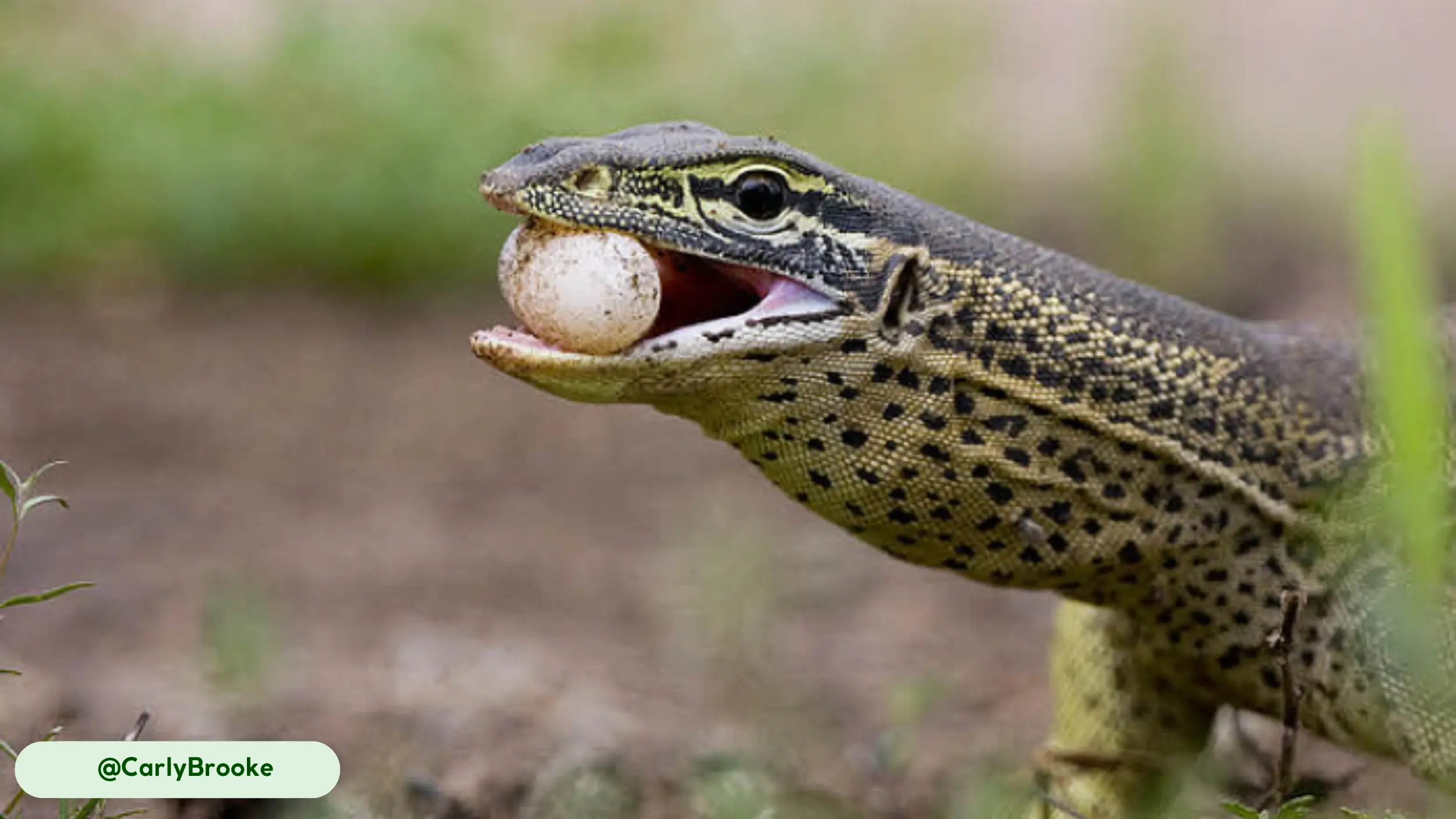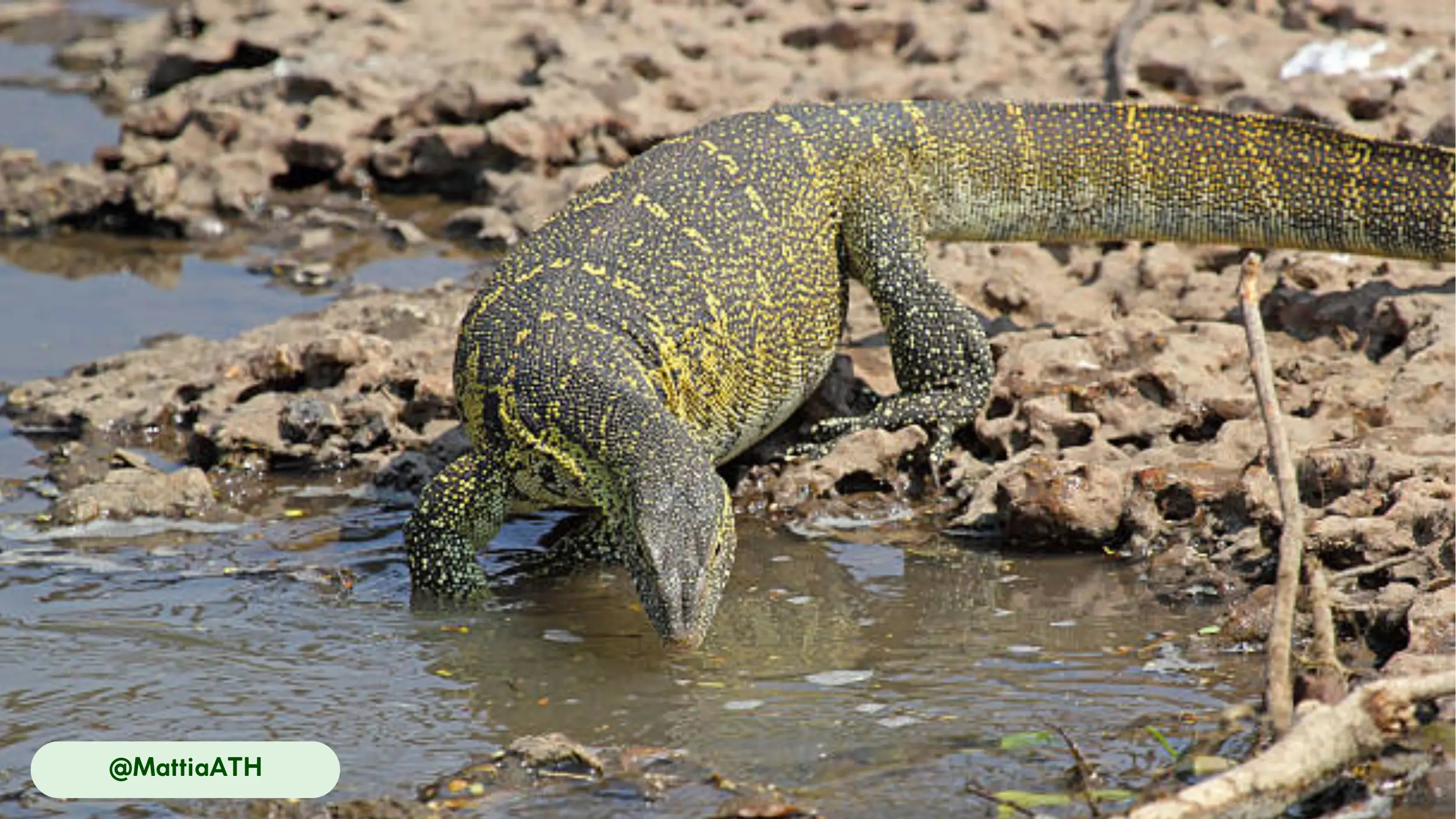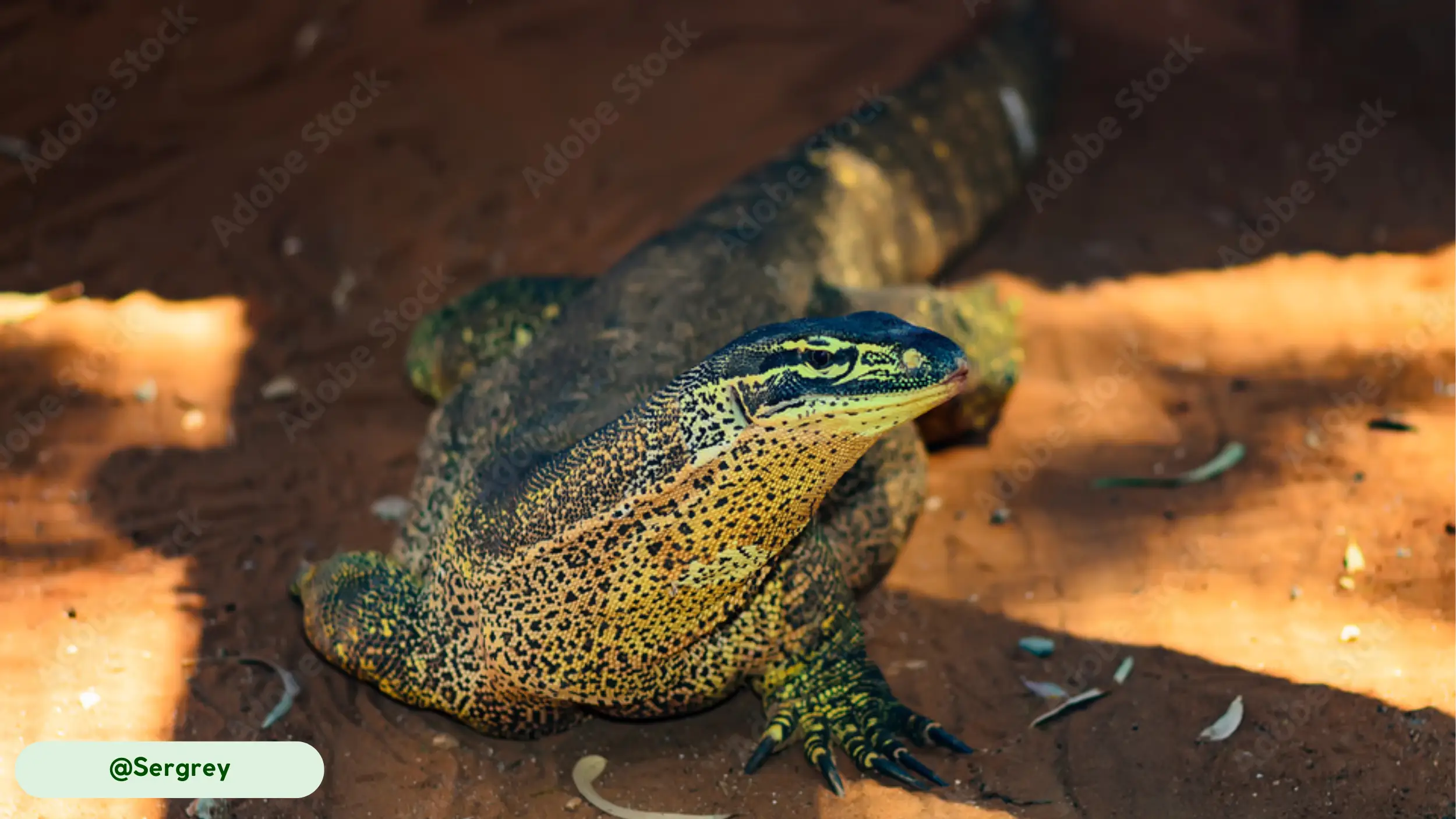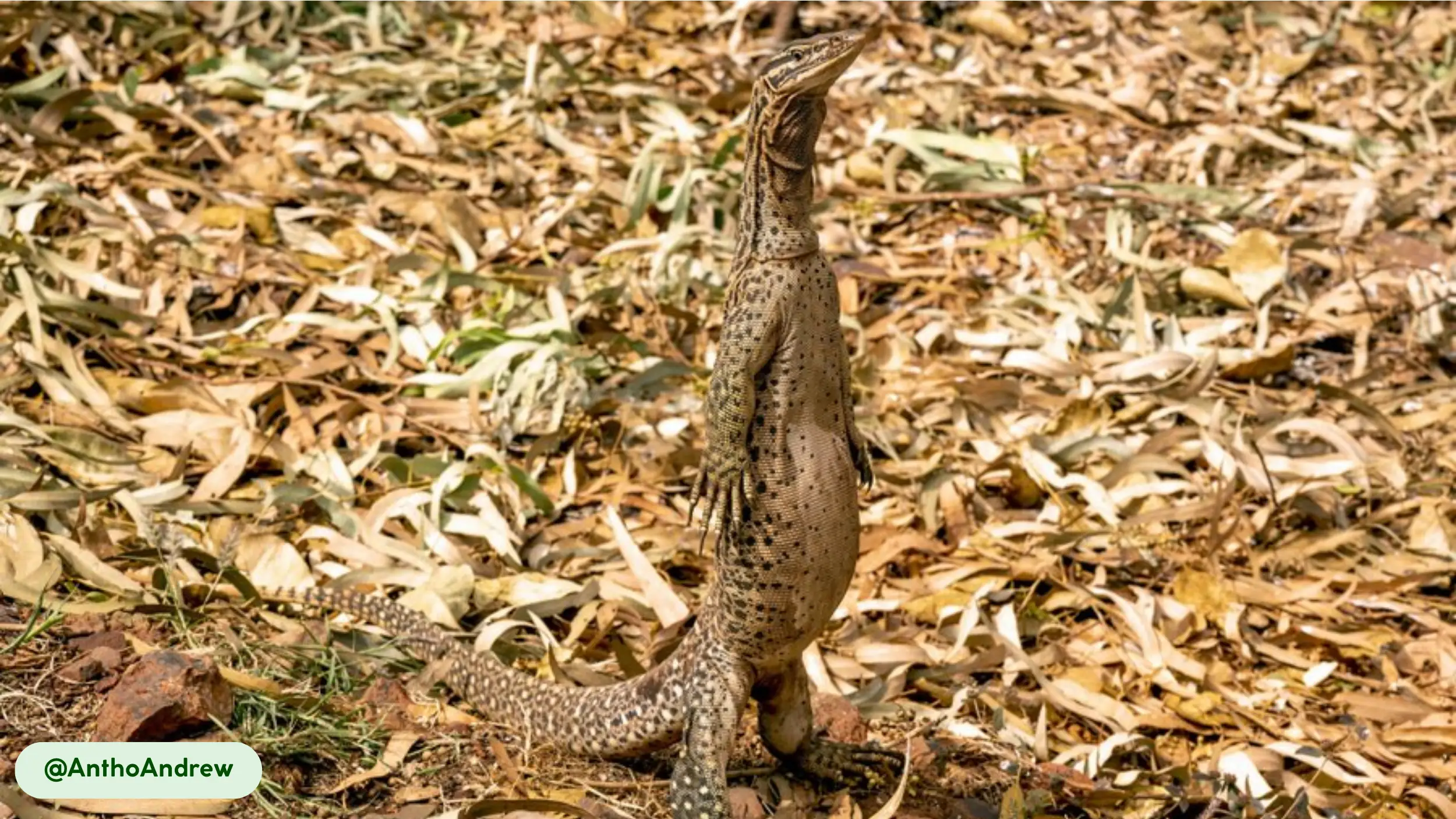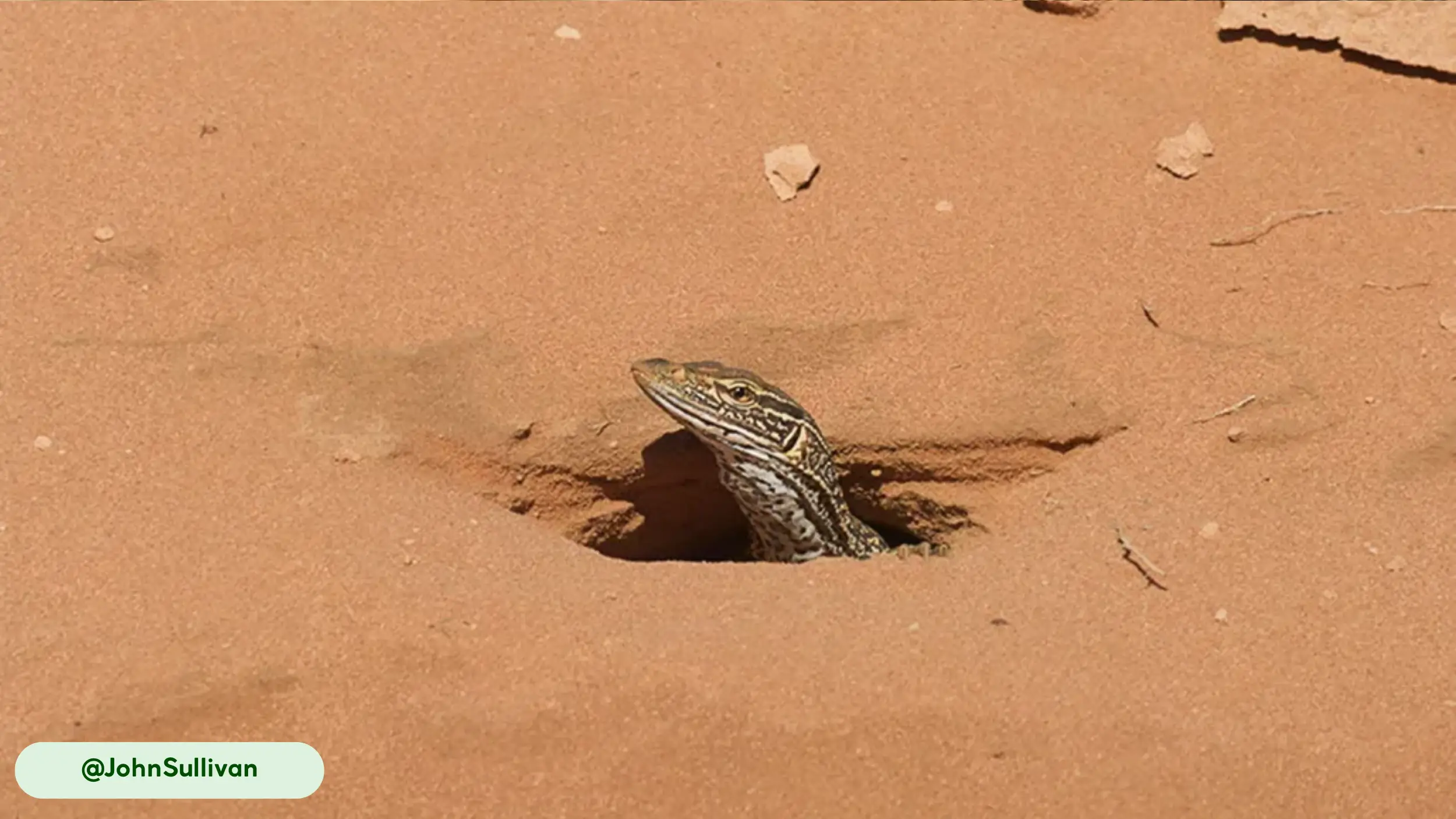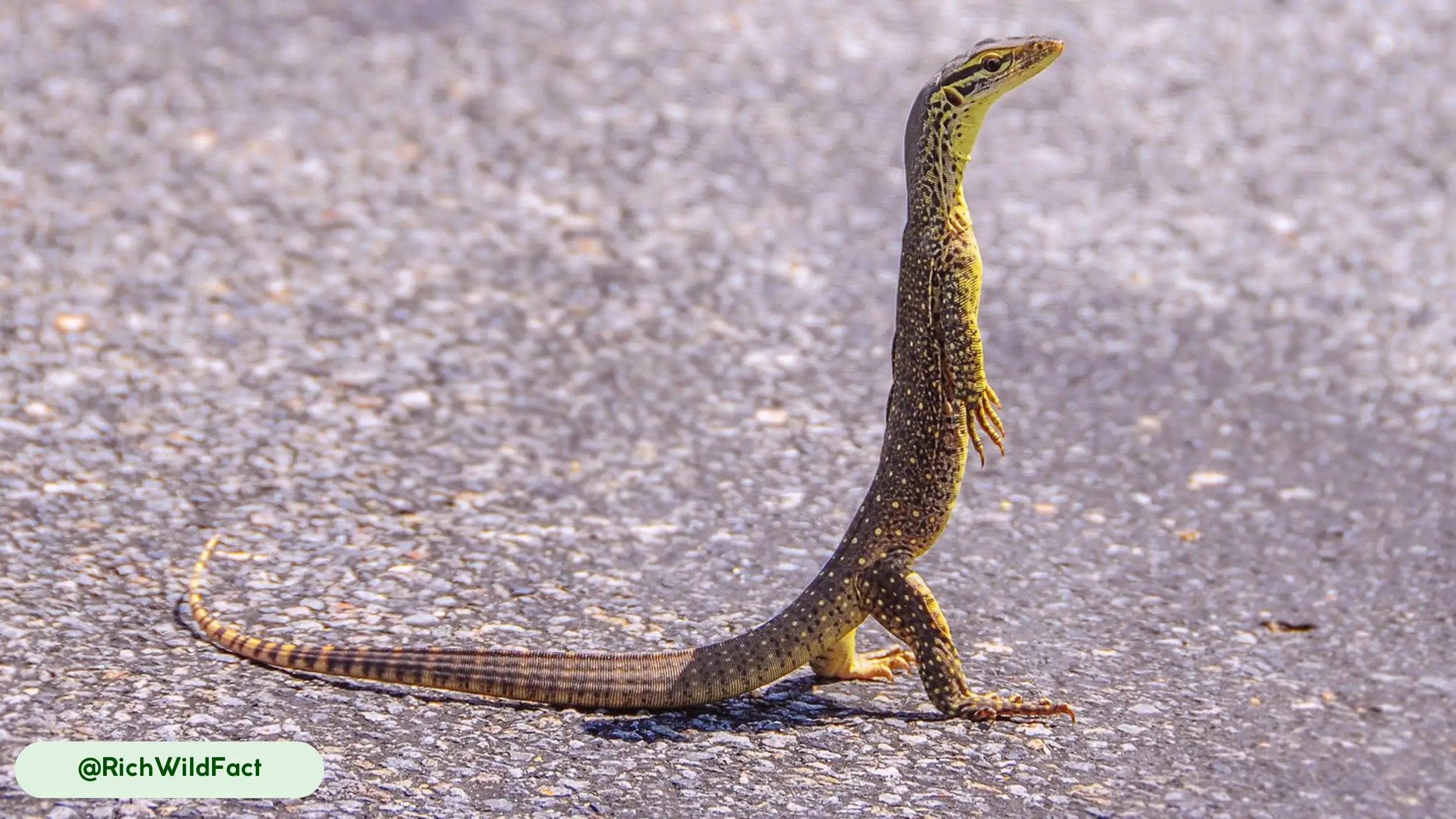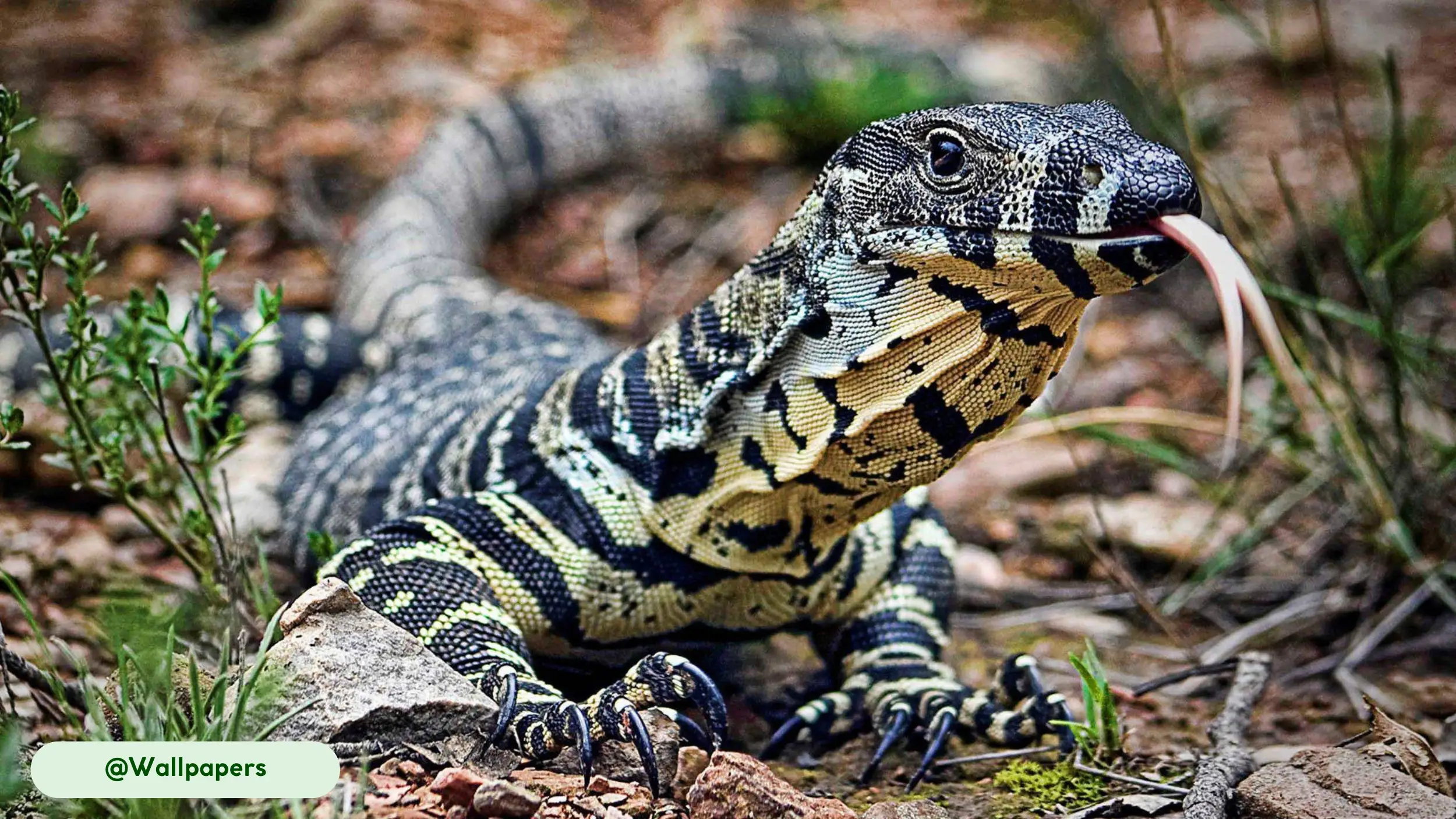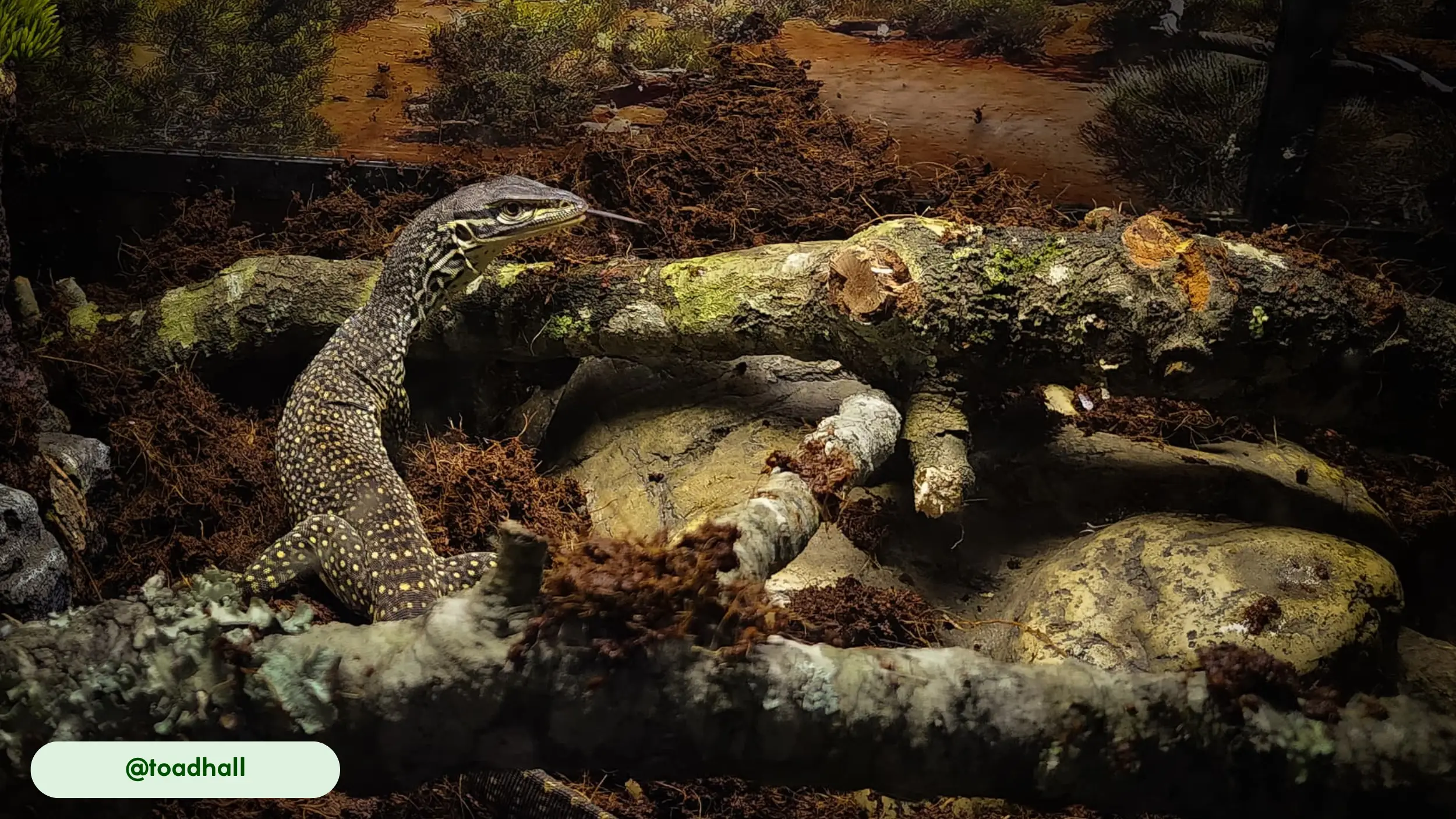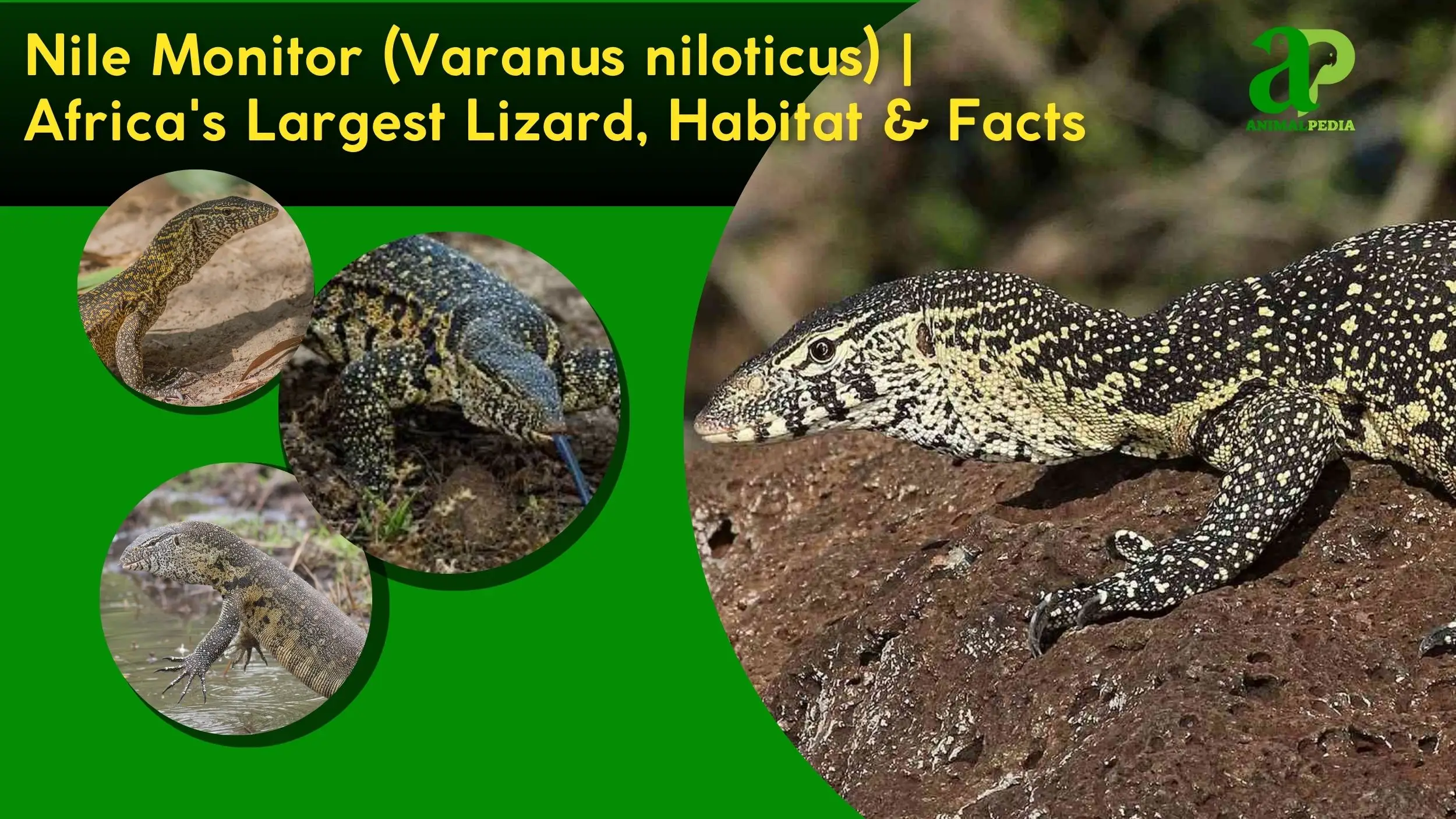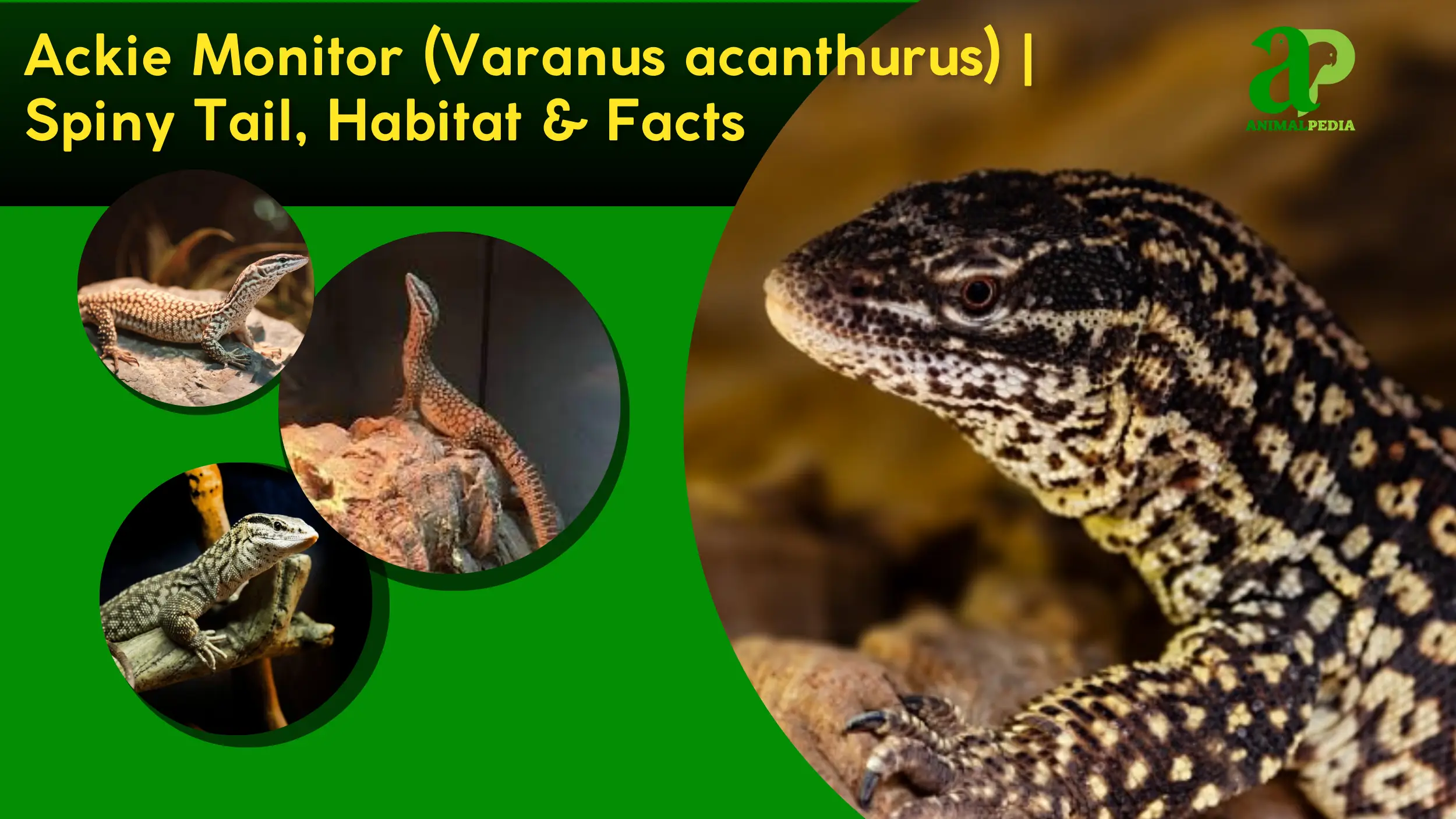Argus Monitors (Varanus panoptes) are large, terrestrial reptiles found across northern Australia and southern New Guinea. This species is a member of the Varanidae family and holds a stable conservation status of Least Concern on the IUCN Red List [12]. Adults measure between 3 to 5 feet (90 to 150 cm) in total length, with a body mass ranging from 13 to 33 pounds (6 to 15 kg) [1, 18].
As pursuit predators, these monitors are highly athletic, capable of reaching speeds of up to 20 miles per hour (32 km/h) over short distances [1]. Their diet is primarily carnivorous, consisting of a wide array of small vertebrates and invertebrates.
This comprehensive guide presents an expert look at the Argus Monitor’s life. From its unique physical characteristics and taxonomic classification to its ecological role and interactions with humans, this article provides a detailed scientific overview of this remarkable animal.
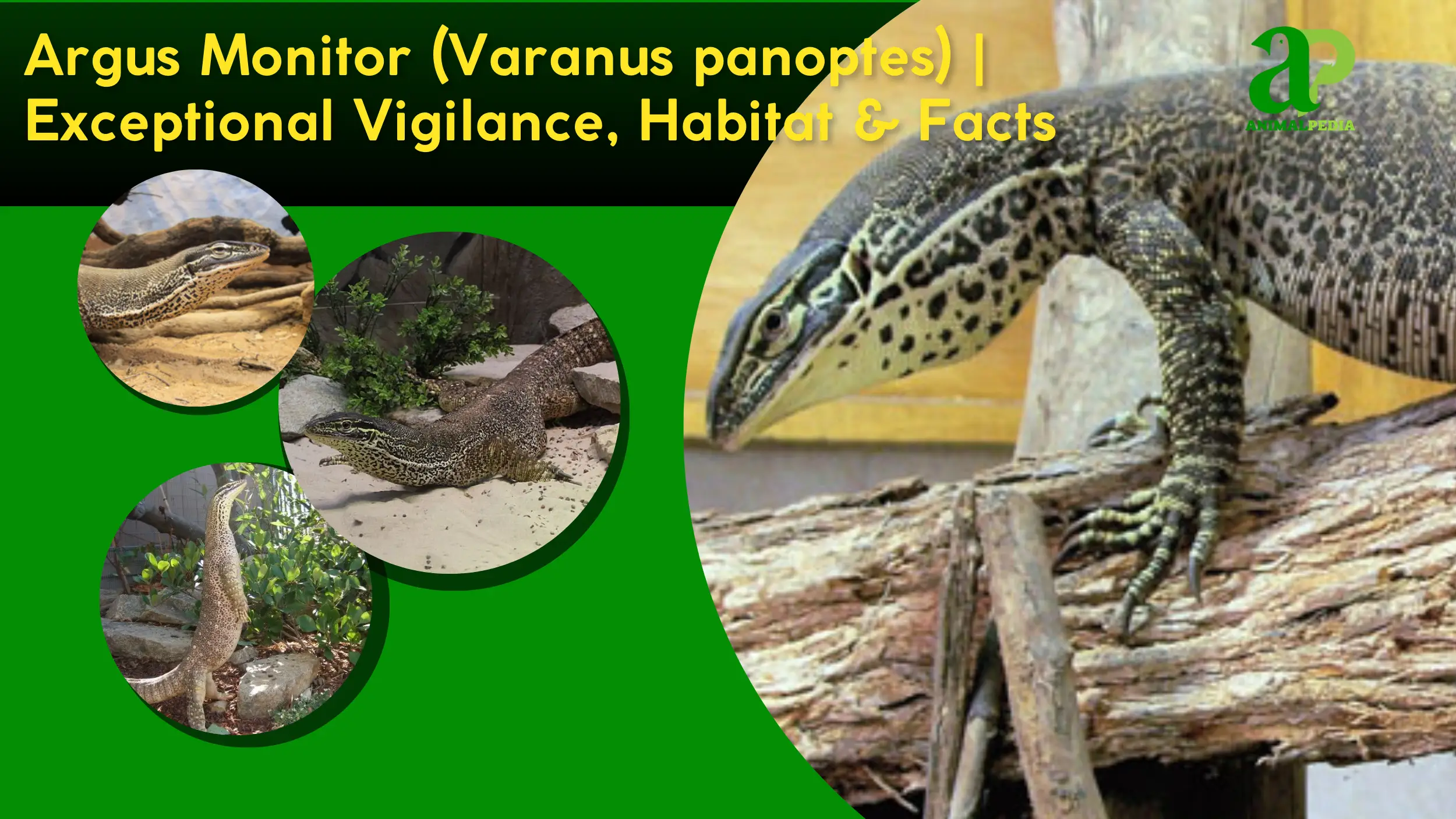
What Is an Argus Monitor?
The Argus Monitor is a large, terrestrial reptile native to Australia and New Guinea, recognized for its exceptional vigilance and strong, athletic build [2, 3]. Scientifically classified as Varanus panoptes, this species belongs to the family Varanidae, the order Squamata, and the class Reptilia [2].
It is also known by other common names, such as the Yellow-spotted Monitor due to its distinctive yellow skin markings and the Floodplains Goanna in Australia, referencing its preferred habitat [3]. The species name, panoptes, is derived from the Greek “pan” (all) and “optes” (seeing), a direct reference to the mythological giant Argus Panoptes, who possessed one hundred eyes [4]. This name highlights the monitor’s behavior of standing on its hind legs to survey its surroundings [4].
There is some scientific discussion regarding the taxonomic distinctions within the species. While some researchers classify Argus Monitors into subspecies based on geographic isolation and minor color variations, others argue that genetic studies show a close affinity that may not justify these divisions [4, 8].
This debate underscores the complexities in reptile taxonomy. Understanding its scientific identity is a starting point. To truly appreciate this reptile, one must examine the physical attributes that make it such a powerful predator.
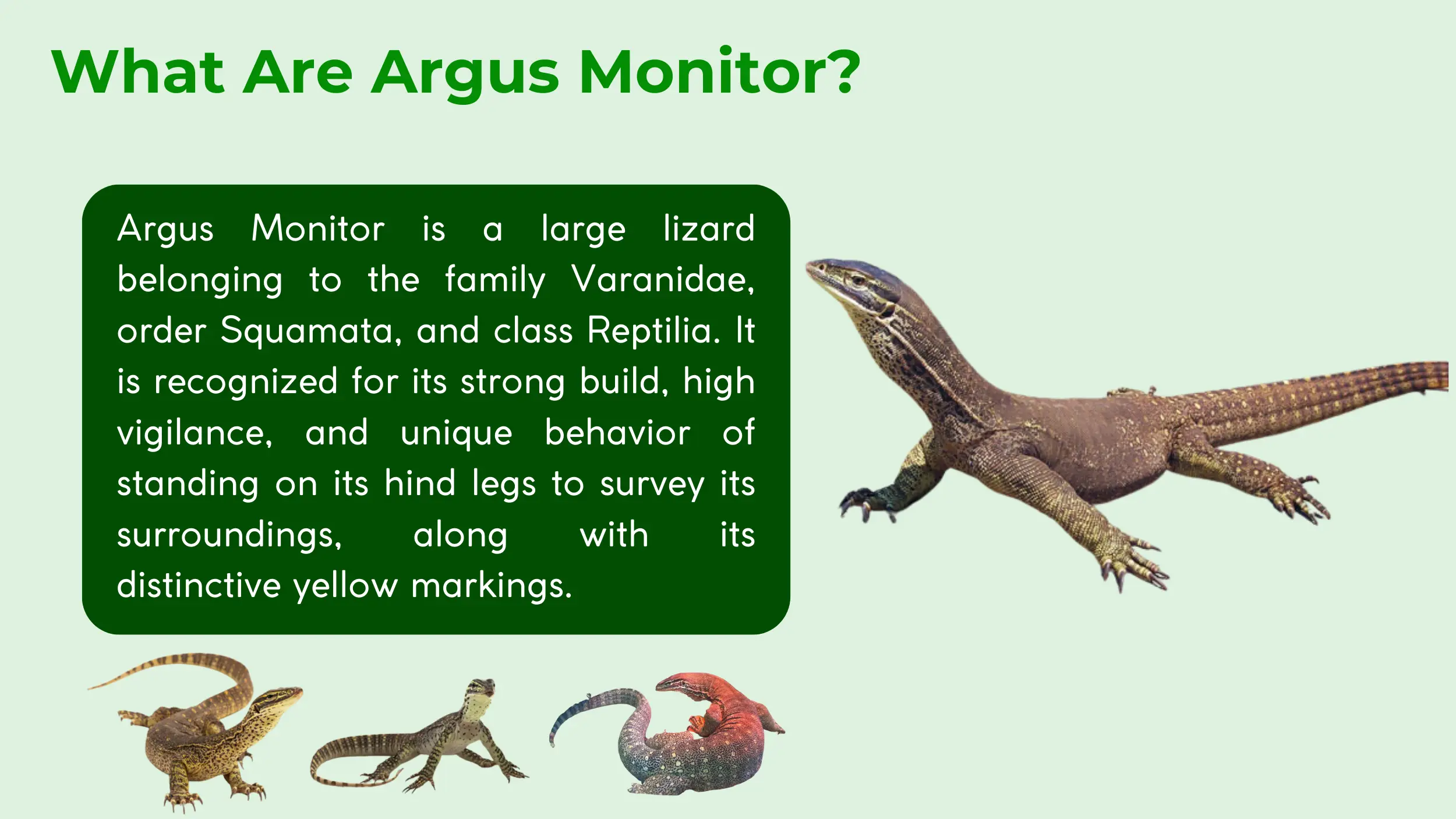
What Does Argus Monitor Look Like?
The Argus Monitor’s physical appearance is defined by its robust and athletic physique, which facilitates its active, terrestrial, and climbing behaviors. The body is primarily dark brown or black, accented with distinct yellow, cream, or white spots that create irregular patterns along its back.
This coloration provides effective camouflage in its savanna and woodland habitats [1]. Its skin is covered in thick, durable scales, which serve as a protective layer against environmental hazards and aid in thermoregulation. The body is elongated, supported by a large, triangular head with a prominent snout.
This species has at least five prominent physical features that distinguish it. Each feature contributes to its survival as a successful predator and agile climber.
- Powerful Limbs: Its four strong limbs are equipped with sharp claws, which are used for digging burrows, climbing trees, and pursuing prey.
- Muscular Tail: The tail is long and muscular, making up nearly two-thirds of the monitor’s total length. It provides balance, assists in swimming, and can be used as a defensive weapon against threats [18].
- Chemosensory Forked Tongue: The forked tongue functions as a highly sensitive sensory organ, allowing the monitor to detect prey and predators by picking up chemical cues from the air, similar to a snake [1].
- Distinctive Head and Eyes: The head is large and robust. The medium-sized eyes have vertical pupils, which provide excellent vision and depth perception, critical for hunting [18].
- Tripod Stance: Argus Monitors display a unique behavior of standing on their hind legs with their tail for support. This “tripod” stance allows them to elevate their vantage point to survey their surroundings and can also be used to intimidate predators by making the monitor appear larger [4].
Sexual dimorphism is evident in the physical appearance of the Argus Monitor. Males are not only significantly larger and heavier than females but also possess broader heads and more robust builds [18]. This difference in size and structure is particularly noticeable in the largest subspecies, V. p. panoptes [15]. These physical attributes are a clear indication of its size and power. It is time to look at the exact measurements that define this reptile.
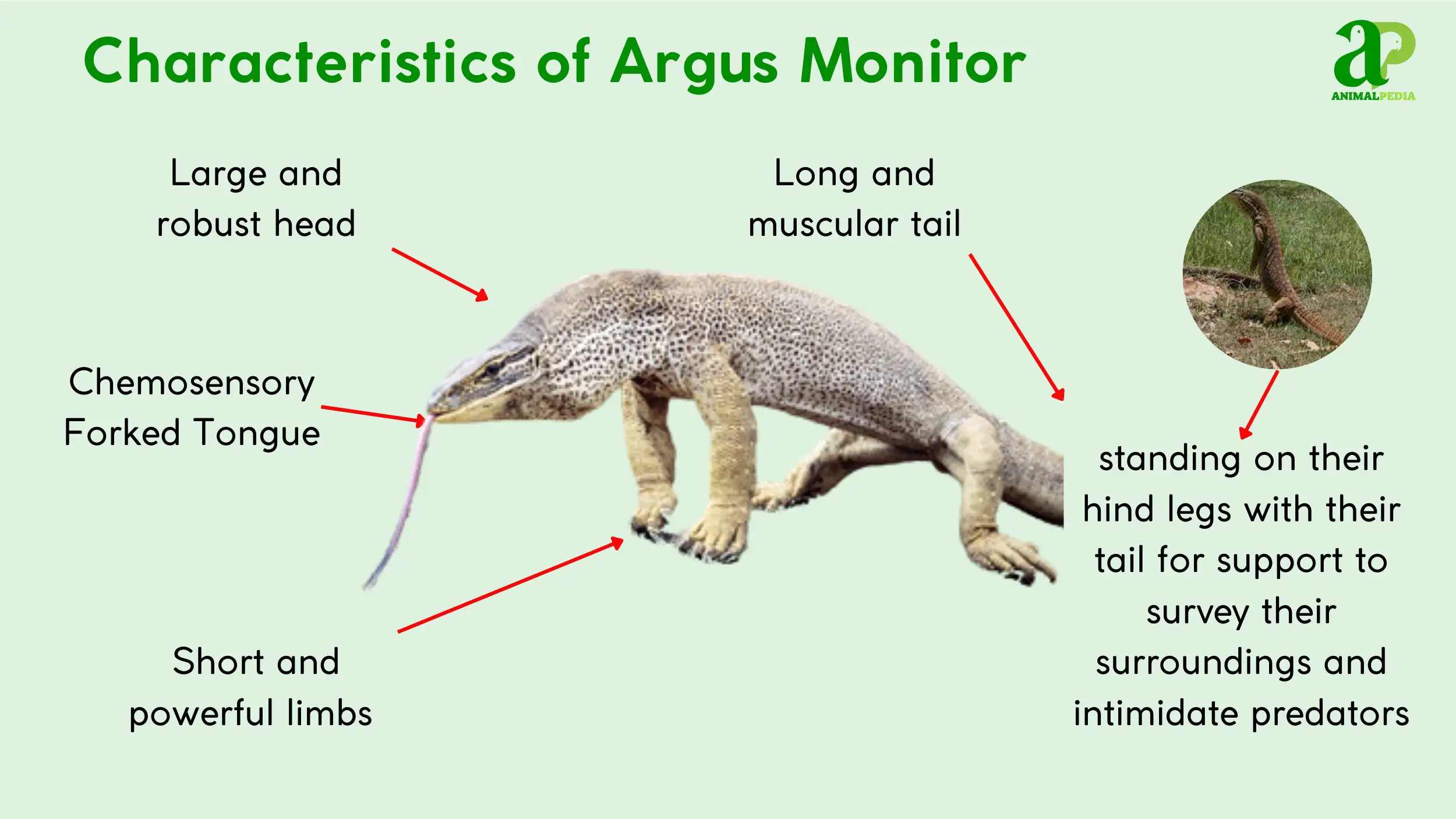
How Big Is Argus Monitor?
The average adult Argus Monitor ranges in size from 3 to 5 feet (90 to 150 cm) in total length. This species exhibits distinct sexual dimorphism, with males growing significantly larger than females.
| Trait | Male | Female |
| Length | 4-5 feet (120-150 cm) [1, 9] | 3 feet (90 cm) [1, 9] |
| Weight | 15-33 pounds (7-15 kg) [1, 9] | 13-22 pounds (6-10 kg) [1, 9] |
| Growth & Record Size | Males grow faster and achieve greater size and weight [1, 9] | Females are smaller, with less weight and a shorter average length [1, 9] |
Hatchlings are quite small, measuring only 10 to 12 inches (25 to 30 cm) and weighing around 0.1 pounds (50 g). Juveniles grow to 2 to 3 feet (60 to 90 cm) [1, 18]. They reach maturity in approximately one to two years [1, 15]. The size difference between a hatchling and an adult male can be compared to the difference between a school ruler and a tall person.
This impressive size is directly related to the expansive habitats where the Argus Monitor lives. Understanding its native range provides a greater appreciation for how it thrives.
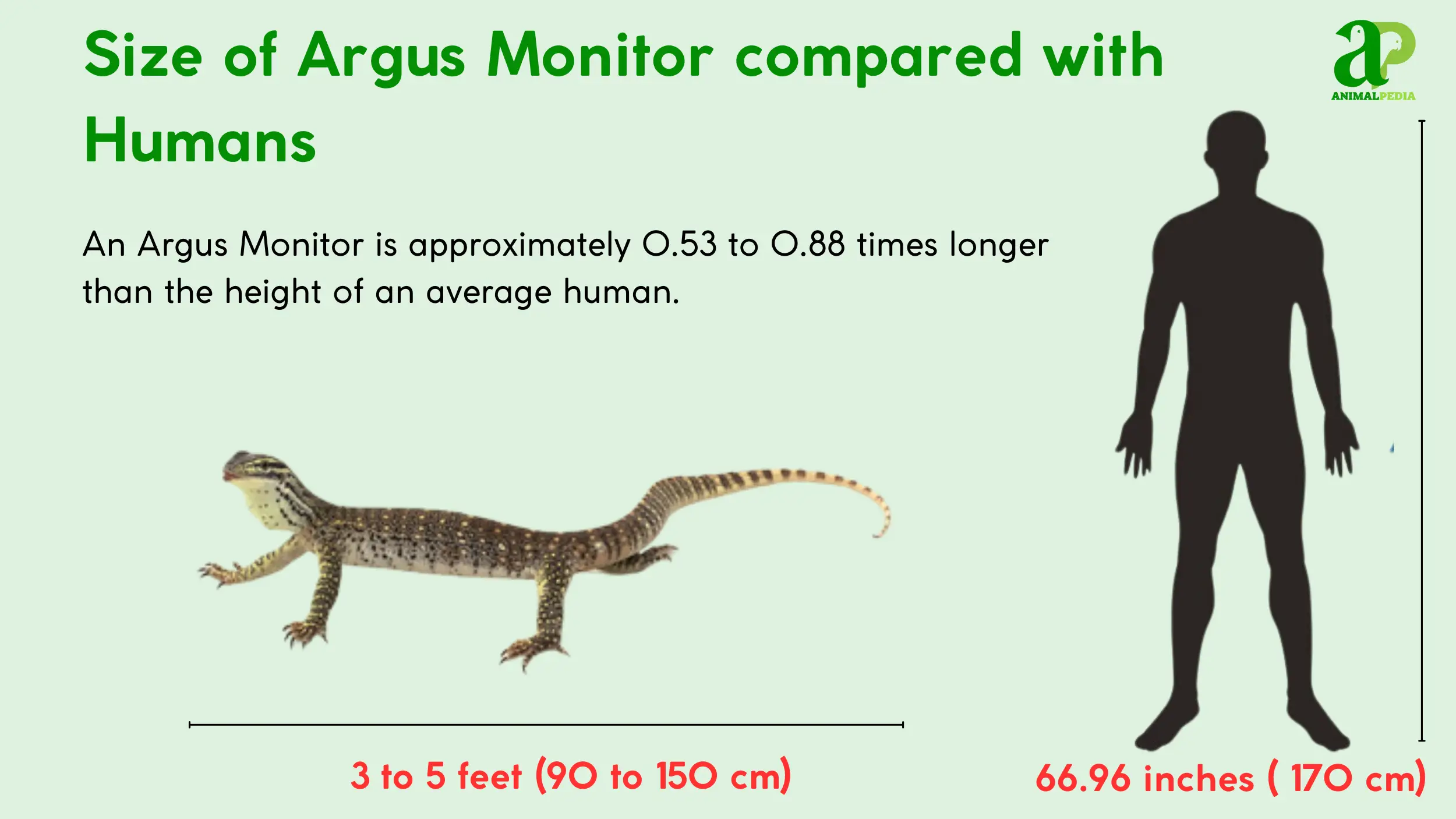
Where Does Argus Monitor Live?
Argus Monitors are found throughout a vast area encompassing northern Australia and the southern portion of New Guinea. They are habitat generalists, meaning they can thrive in various environments, but they show a strong preference for specific ecological niches.
These include tropical savannas, woodlands, grasslands, and particularly the floodplains and riparian zones along rivers and swamps [3, 7]. Their adaptability allows them to persist across a wide geographic range despite regional differences in vegetation and climate.
A significant behavioral trait is their preference for habitats near permanent water sources. These monitors are adept swimmers and will readily enter water to hunt prey or escape from predators [2].
Their terrestrial lifestyle is further defined by their skilled burrowing ability. They excavate deep burrows in sandy soil, which serve as crucial shelters from extreme temperatures and provide a safe refuge from predators [11, 22].
Their thermal regulation is closely tied to their burrowing and water-seeking behaviors, highlighting the species’ deep connection to its environment. The combination of their powerful physique, burrowing prowess, and semi-aquatic tendencies makes them well-suited to the diverse and often challenging ecosystems of their native range.
This mastery of their environment, however, has also exposed them to modern threats, such as the invasion of toxic cane toads, which have caused localized population declines in some areas of their Australian habitat [7]. This intimate relationship with its environment directly shapes its daily behaviors. A closer look at how the Argus Monitor acts reveals its remarkable adaptability and cunning as a predator.
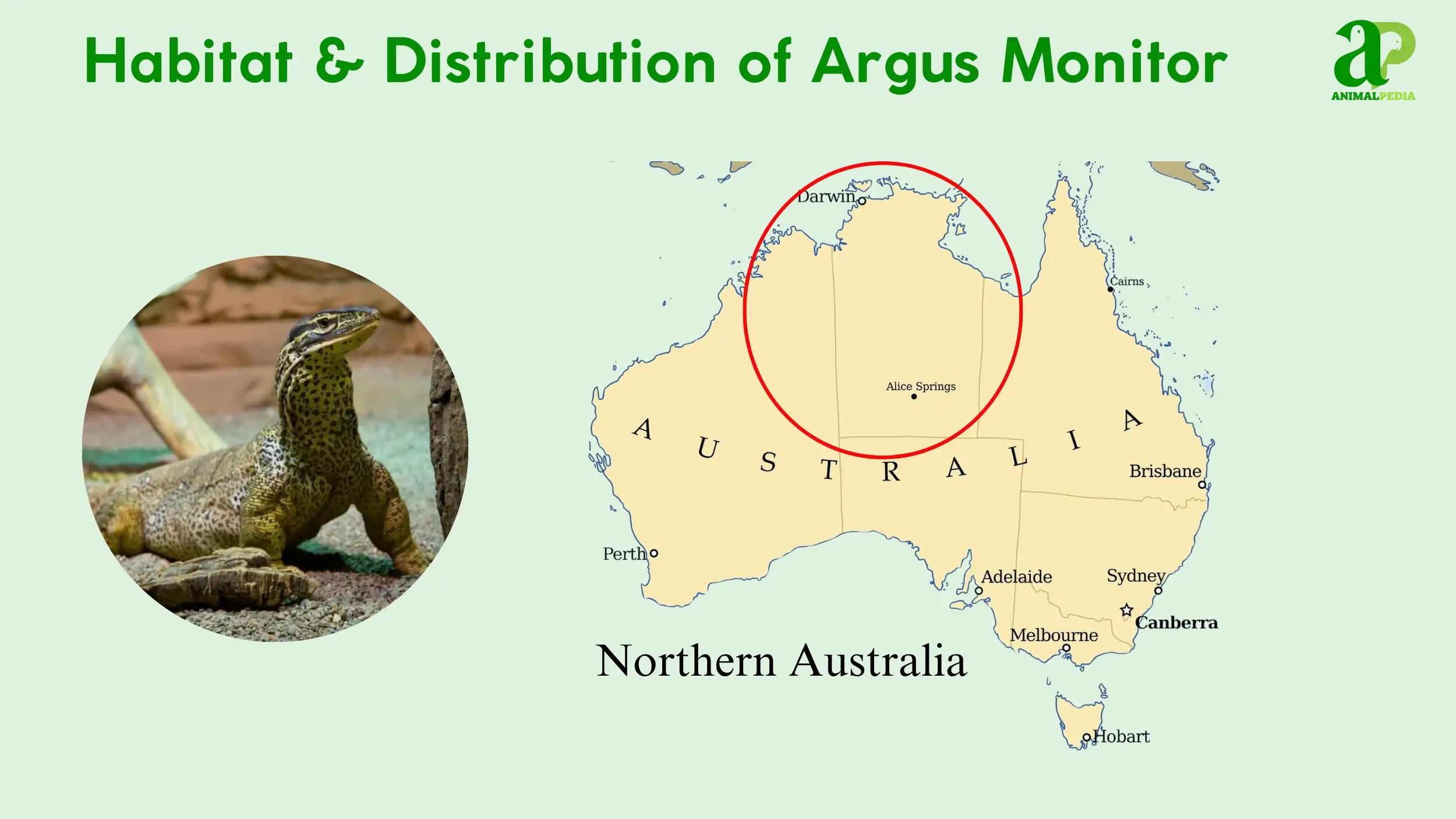
How Does Argus Monitor Behave?
The Argus Monitor is a highly vigilant and active predator, displaying a range of behaviors for survival. These include complex hunting and feeding strategies, diverse movements across land and water, and specific daily and seasonal activity patterns.
- Diet and Feeding: This species primarily preys on small vertebrates and invertebrates, utilizing a keen sense of smell to locate its meals [18].
- Movement and Abilities: Argus Monitors are agile and athletic, capable of running, climbing, and swimming with specialized physical attributes for each type of movement [10, 12].
- Daily/Seasonal Patterns: This diurnal reptile manages its body temperature and activity levels through a predictable cycle of basking, foraging, and sheltering to navigate environmental changes [12].
The following sections provide a more detailed look at these behavioral categories. A key part of its behavior is its predatory nature, which begins with its diverse diet and feeding habits.
Diet and Feeding
Argus Monitors are classified as opportunistic carnivores, with their diet consisting of various prey items depending on availability. This species primarily consumes small vertebrates such as small lizards, snakes, birds, and rodents, as well as a range of invertebrates like insects, spiders, and crustaceans [1, 18].
A study on monitor lizards found that they use their highly developed chemosensory forked tongue to track scent trails, a process known as lingual flicking, to locate prey hidden in burrows or dense vegetation [18]. This method of prey detection is a primary hunting tool [1].
These monitors are active pursuit predators that often chase down their prey, using their impressive speed and agility. They seize their meal with powerful jaws and sharp teeth, often consuming it whole [18]. Their feeding is characterized by a voracious appetite, with monitors able to consume large quantities of food when it is available [1].
This feeding pattern allows them to build fat reserves for periods of food scarcity. The need to pursue its prey is directly tied to the monitor’s physical abilities and movements. These incredible skills are essential for its survival in the wild.
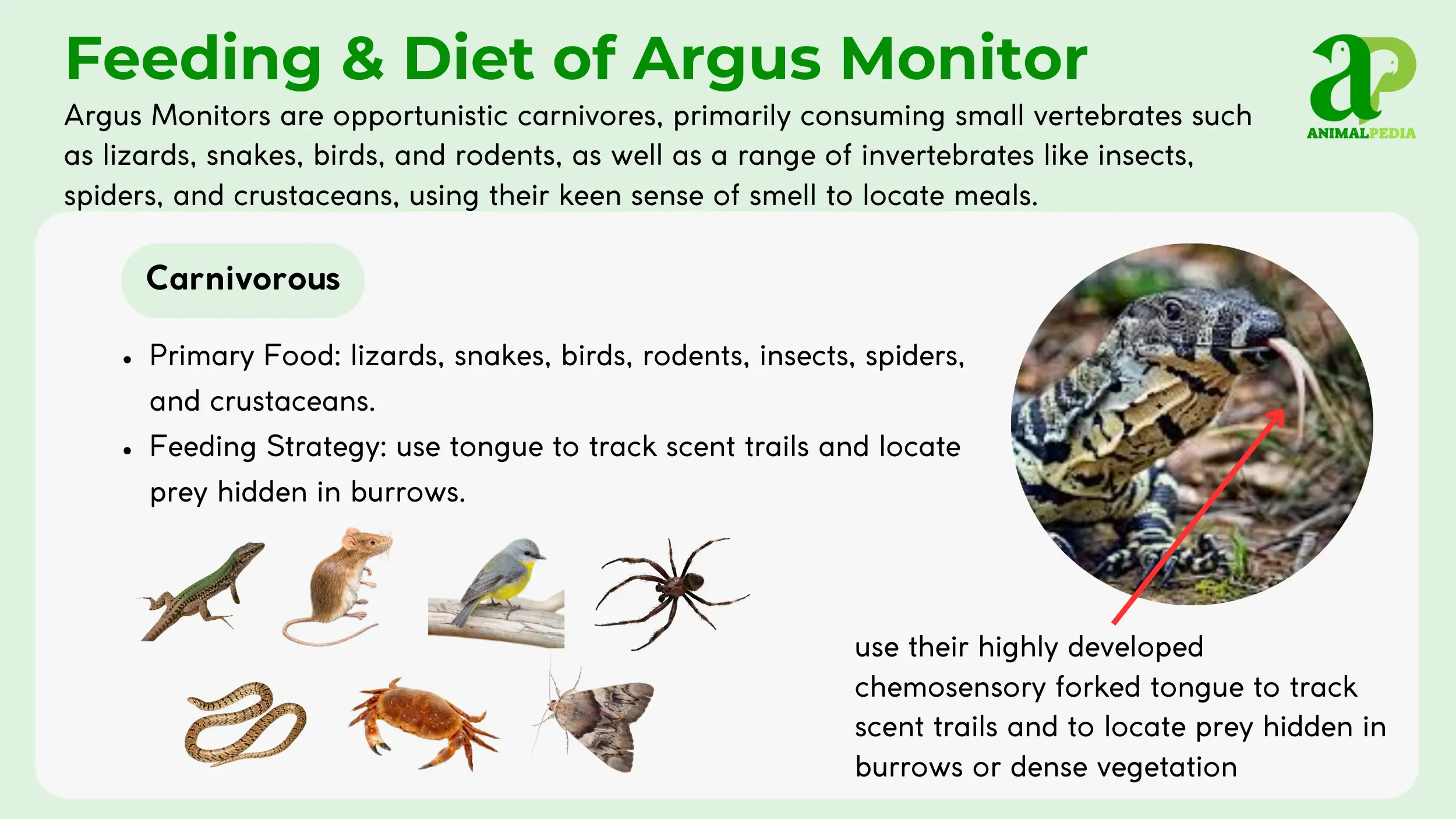
Movement and Abilities
Argus Monitors exhibit highly versatile movement, utilizing both terrestrial and semi-aquatic modes of locomotion. Their movement types include running, climbing, and swimming, each supported by their powerful physique. The most prominent physical capability of this monitor is its speed, which can reach up to 20 miles per hour (32 km/h) over short distances [1, 12]. This explosive speed is a key part of their pursuit predation strategy.
Their muscular limbs and sharp claws are crucial for a variety of tasks. On land, they are powerful diggers, capable of excavating extensive burrow systems for shelter. They can also climb trees with surprising agility to hunt or escape danger [10]. In water, they are adept swimmers, propelling themselves with powerful, undulating movements of their tails [2].
A unique special ability of the Argus Monitor is its tripod stance, where it stands on its hind legs with its stiff tail acting as a third support [4]. This behavior allows the animal to gain an elevated vantage point to scan for threats or potential prey [12]. The use of these abilities is not random but follows a predictable pattern. Its daily and seasonal rhythms are crucial for understanding its survival.
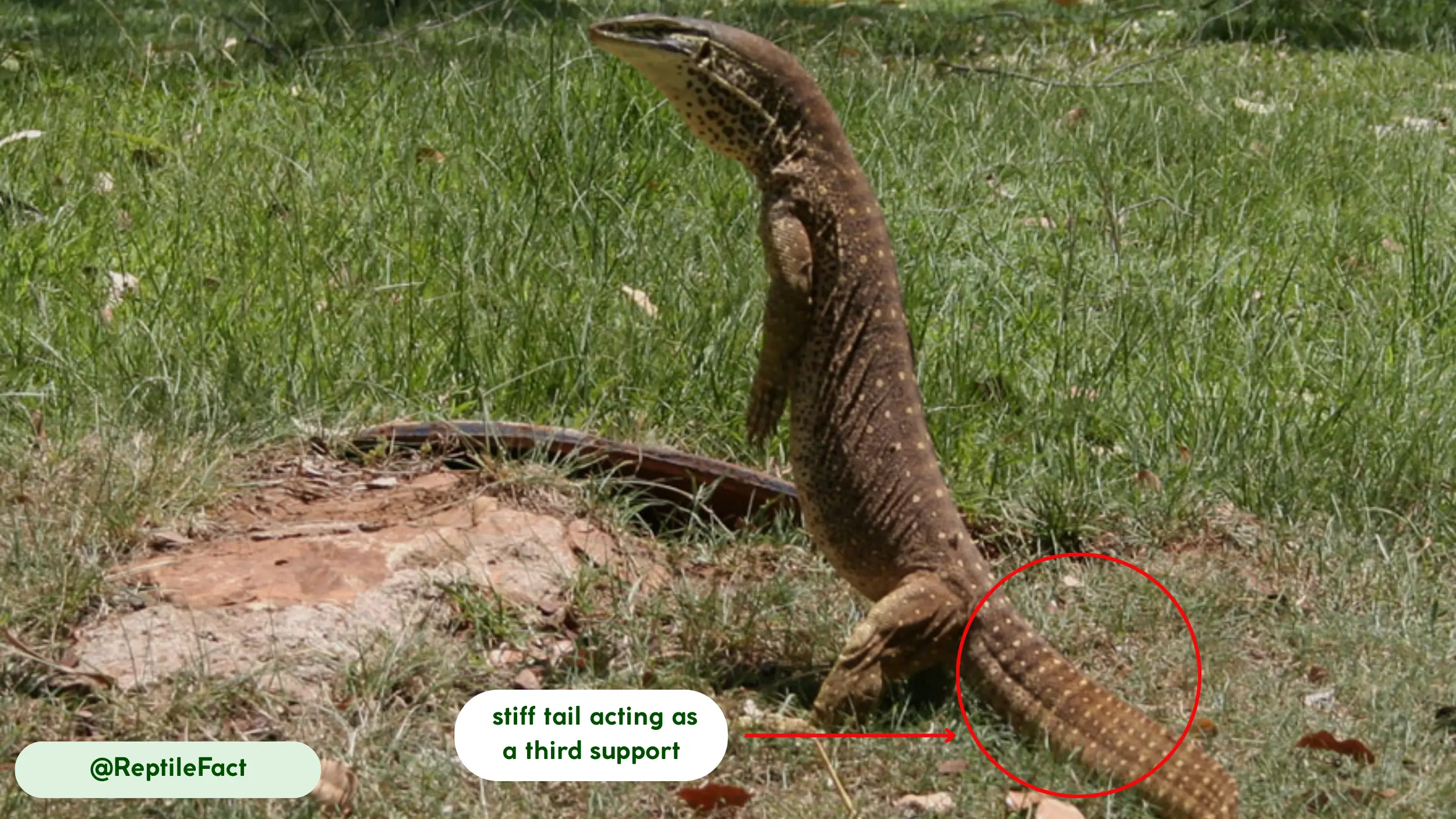
Daily/Seasonal Patterns
Argus Monitors are diurnal, meaning they are active during the day. Their daily cycle is largely driven by thermal regulation, as they are ectothermic and rely on external heat sources for their body temperature regulation. The monitor’s day begins in the morning, when it emerges from its burrow to bask in the sun, raising its body temperature to an optimal level for activity. Once warmed, the monitor spends the late morning and early afternoon actively foraging, hunting, and exploring its territory [12].
As evening approaches and temperatures drop, the monitor retreats to the safety and thermal stability of its burrow [22]. This behavior is part of a larger seasonal pattern. Activity levels are at their peak during the warmer, wet season, when food is abundant. They become less active during the colder, drier months, often remaining in their burrows for extended periods to conserve energy [12].
This species does not undertake long-distance migrations. Instead, they remain within an established home range, using their physical adaptations to navigate seasonal changes. These cyclical patterns are not only for survival but also form the basis for their reproduction.
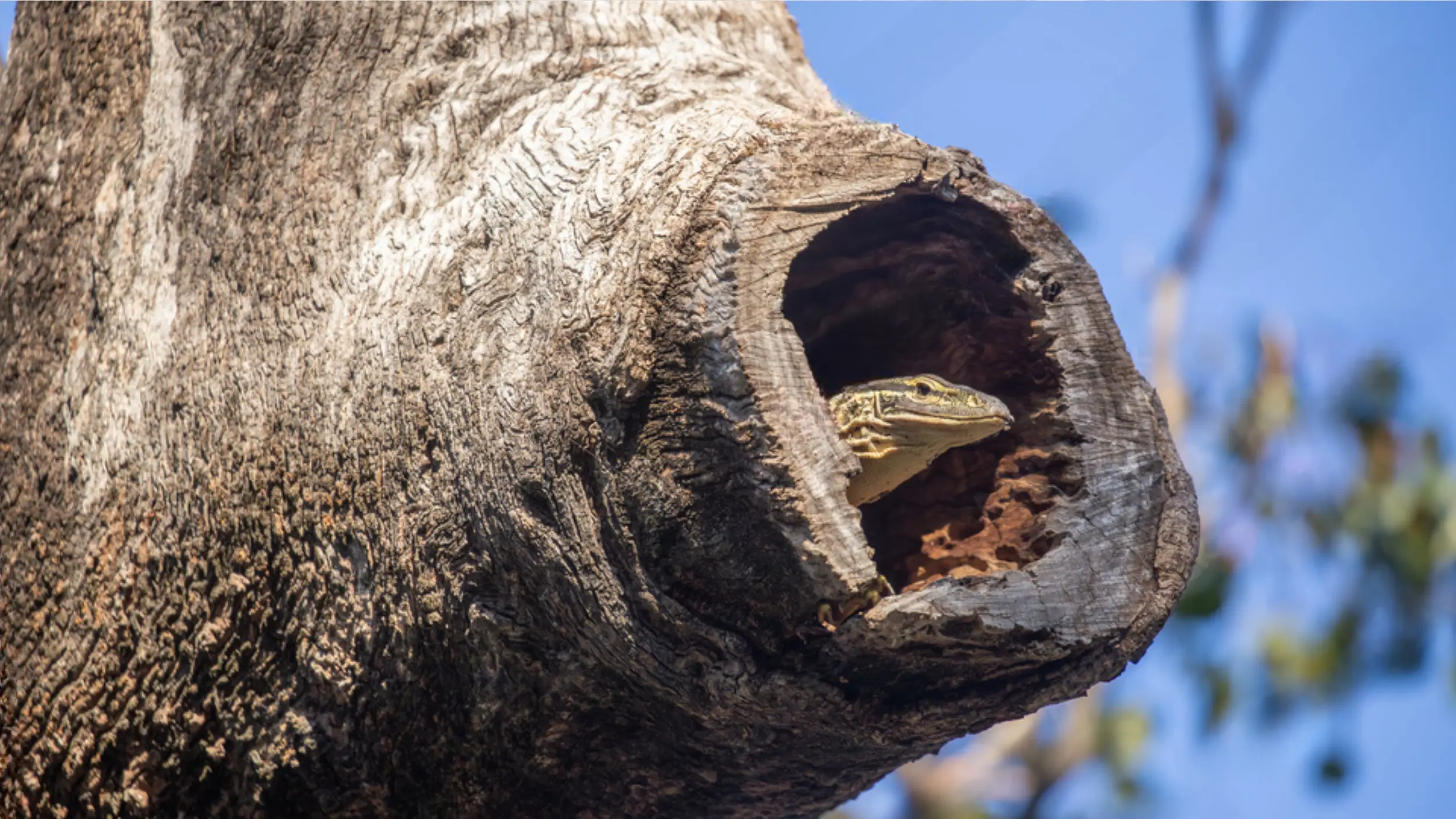
How Does Argus Monitor Reproduce?
Argus Monitors are oviparous, meaning they reproduce by laying eggs. This species’ mating season generally occurs during the wet season, from around January to March, when conditions are favorable for nesting and the availability of resources is high [16]. Courtship behavior involves males asserting dominance through ritualized wrestling matches to gain access to females [16]. After mating, the female excavates a deep burrow or finds an existing one to serve as a nesting chamber.
Females lay a clutch of 10 to 20 eggs, with an average of 14 eggs per clutch, in a chamber often located at the end of a long, narrow tunnel [8, 16]. These nests are considered cryptic due to their complexity, which makes them difficult for predators to find [8].
The eggs incubate for an average of 250 days, though this period can vary with temperature fluctuations [16]. Argus Monitors do not exhibit parental care; once the eggs are laid, the female covers the nest and leaves [16]. The hatchlings are independent upon emergence and must find their own food and shelter. The ultimate outcome of this process is the continuation of the species, and this is measured by its lifespan.
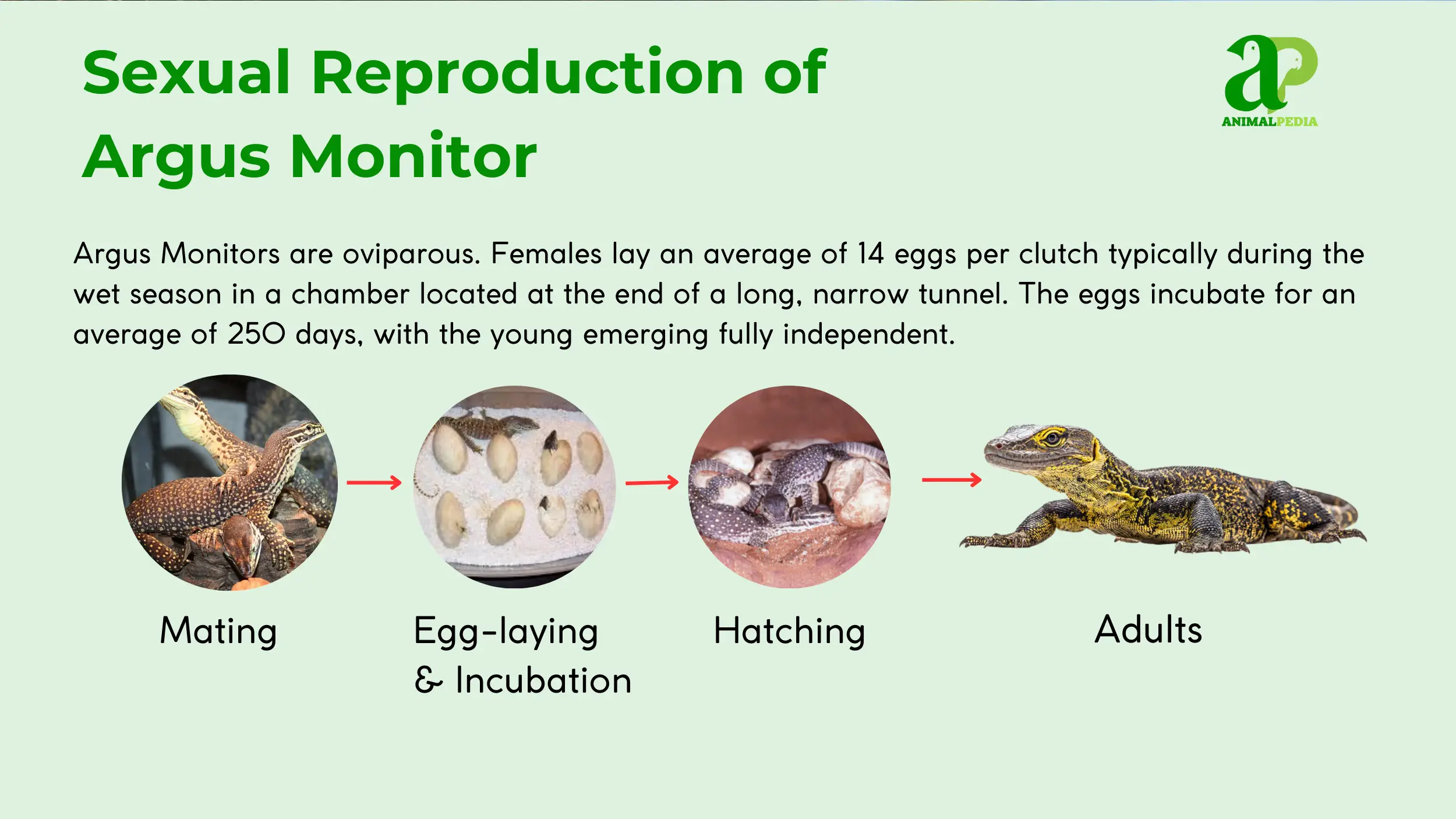
How Long Does Argus Monitor Live?
Argus Monitors live for approximately 10 to 15 years in the wild. Their lifespan is affected by several factors, including habitat quality, food availability, and predation [14]. In captivity, these monitors can live significantly longer, often reaching over 20 years [14]. The difference is due to stable environmental conditions, a consistent diet, and the absence of natural predators.
Argus Monitors reach sexual maturity at approximately one to two years of age, though this can vary depending on growth rate and health [1, 15]. The longevity of an individual is influenced by its ability to navigate challenges like food scarcity and predation.
A secure and healthy habitat, characterized by an ample supply of food and suitable burrowing sites, directly correlates with a longer lifespan [14]. The species’ robust health and general resilience contribute to its overall durability within its natural range. The ability to thrive for decades is a testament to the monitor’s resilience. This endurance is linked to its ecological role and its complex relationship with the human world.
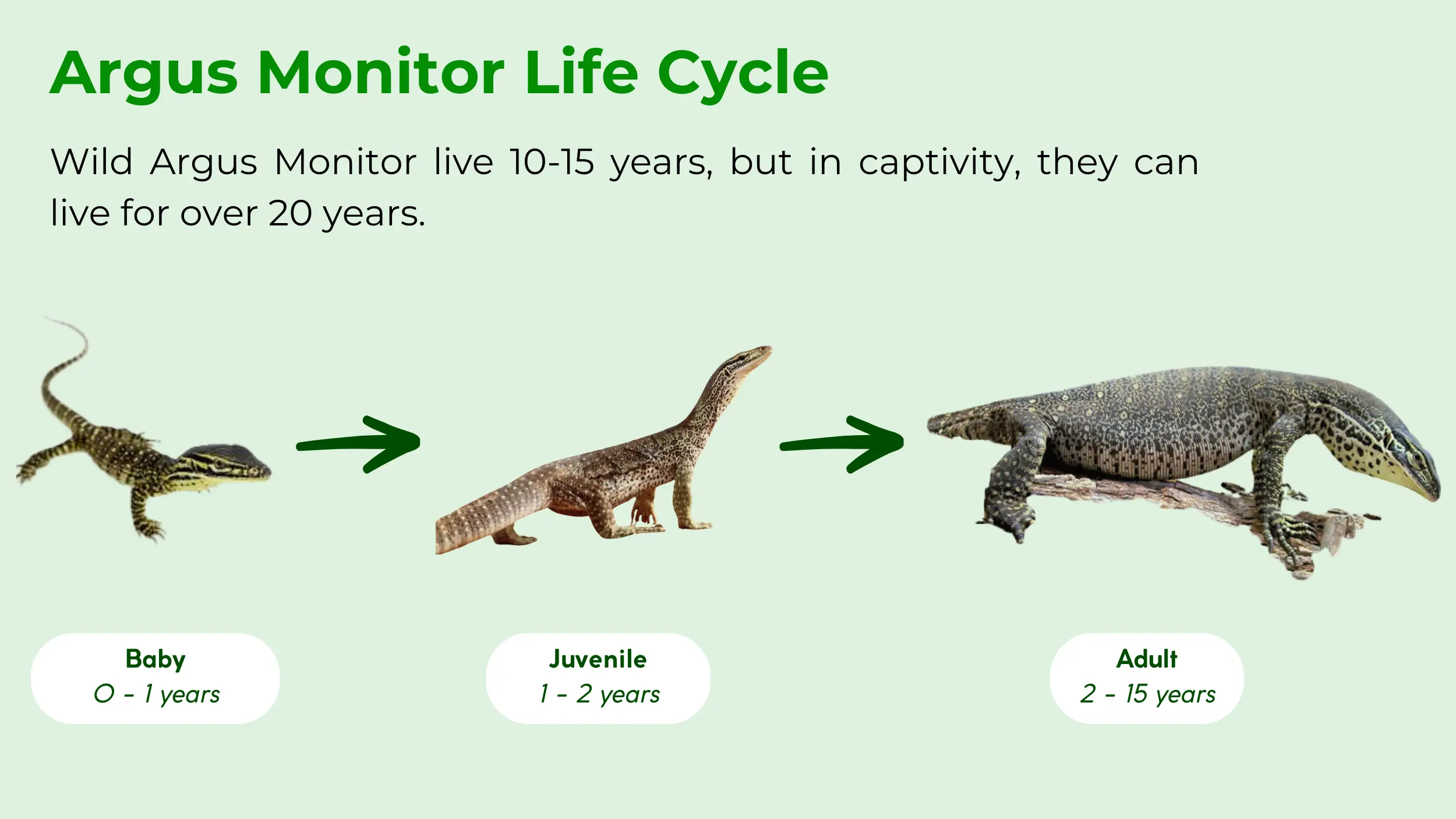
Is Argus Monitor Beneficial to Humans?
Argus Monitors are beneficial to humans due to their significant role as a natural pest control agent in their native ecosystems. As opportunistic predators, they help regulate populations of rodents, insects, and other small animals that can damage crops or carry diseases. This natural regulation contributes to a healthy and balanced ecosystem, which indirectly benefits human agriculture and public health [20].
The monitors also hold cultural significance for some Indigenous communities in their native Australia, serving as a food source and featuring in traditional stories and art [23]. While their value as a natural predator is undeniable, their role in the exotic pet trade can lead to the illegal collection of individuals from the wild, posing a threat to local populations if not managed responsibly. These benefits, however, do not mean the species is free from human-related threats. It is important to look at its conservation status to understand its overall health as a species.
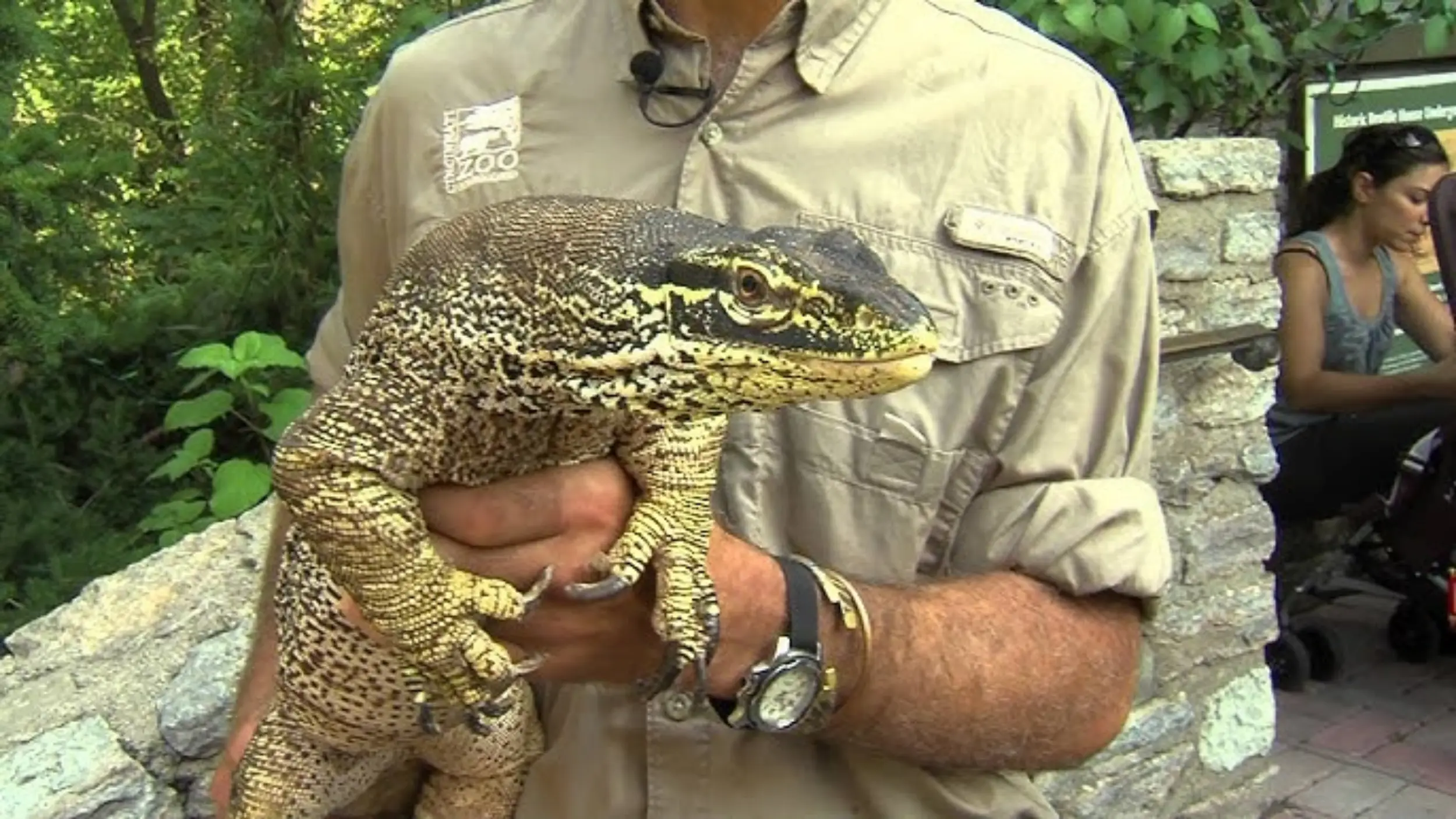
Is Argus Monitor Endangered?
The Argus Monitor is not an endangered species; it is currently listed as a species of Least Concern by the IUCN Red List, reflecting its wide distribution and stable population numbers [12, 15]. Despite this stable status, the species faces specific threats.
The most significant threat in its Australian range is the invasion of the toxic cane toad (Rhinella marina). These toads, when consumed, are lethal to monitors and have caused a decline in monitor populations in some areas [7]. Other threats include habitat loss due to development and human conflict, which can lead to localized population declines.
The ecological importance of the Argus Monitor as a top predator cannot be understated. By preying on small animals, they maintain balance within their ecosystem [20].
Conservation efforts aimed at managing the cane toad invasion and protecting natural habitats are crucial for the long-term survival of this species, ensuring its continued role in the ecosystem. This stable conservation status allows for greater focus on the unique and fascinating aspects of this creature. There is much more to learn about this monitor beyond its conservation status and basic biology.
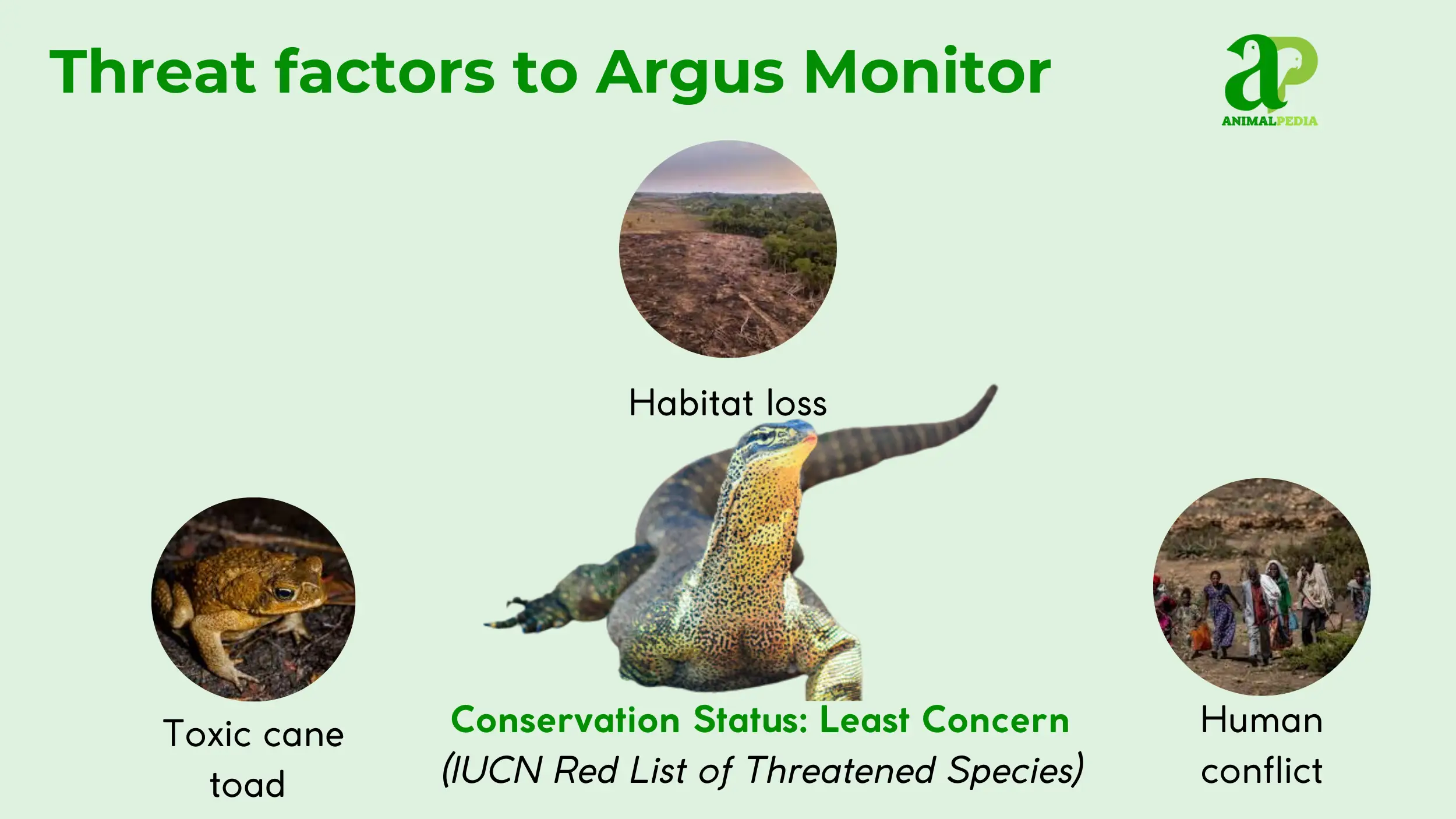
Frequently Asked Questions About Argus Monitor
What is the evolutionary history of the Argus Monitor?
The Argus Monitor belongs to the family Varanidae, an ancient lineage of lizards dating back to the late Cretaceous period. They are part of a monophyletic group of Australian monitor lizards, suggesting a common ancestor that diverged from Asian monitors after the continents separated [19].
What role does the Argus Monitor play in seed dispersal?
The Argus Monitor does not play a significant role in seed dispersal. As a carnivorous species, their diet is composed of other animals, including small vertebrates and invertebrates [18]. They do not consume fruits or vegetation that would allow for the distribution of seeds.
How do Argus Monitors communicate with each other?
Argus Monitors communicate through a variety of non-vocal means. They use visual displays, such as specific body postures and tail movements, to signal dominance or submission. Chemical cues, or pheromones, are also used to mark territory and attract mates [16].
How do Argus Monitors adapt to seasonal flooding in their habitat?
Argus Monitors are well-adapted to the seasonal flooding of their floodplain habitats. They are strong swimmers and will readily enter the water to move between terrestrial areas. They can also seek refuge by climbing trees, which allows them to escape rising water levels [22].
What is the significance of their burrowing behavior beyond nesting?
Beyond nesting, burrowing is a critical thermoregulatory and survival behavior. Argus Monitors use burrows to escape extreme temperatures, both heat and cold. They can also use these subterranean tunnels to ambush prey or hide from predators [17].
Conclusion
The Argus Monitor stands as a prime example of an animal whose reputation for vigilance is backed by a powerful suite of behaviors and physical traits. From its tripod stance to its crucial role as a natural predator, this species embodies resilience and adaptability in its native habitats.
For more on the fascinating world of reptiles and other species, Animal Pedia offers an unparalleled, comprehensive library of scientifically accurate, interactive content. We invite you to explore our collection to deepen your understanding of the world’s diverse fauna.

